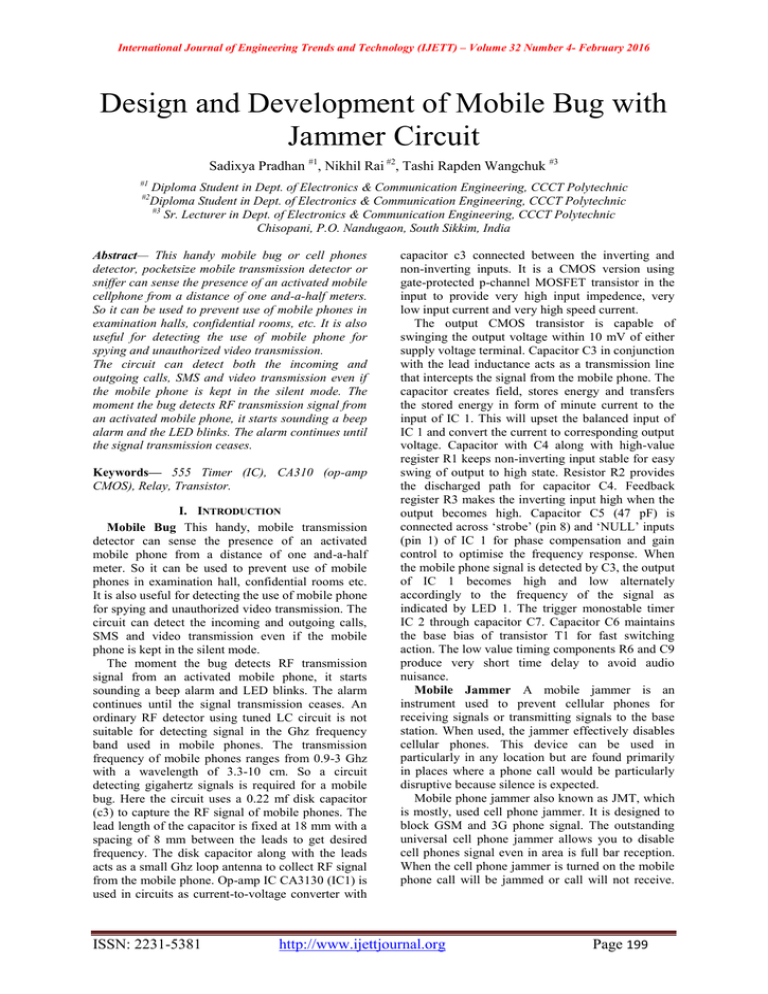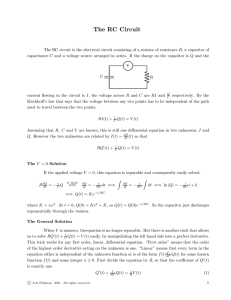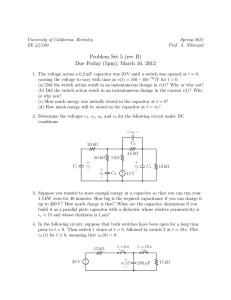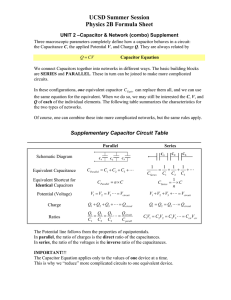Document 12917254
advertisement

International Journal of Engineering Trends and Technology (IJETT) – Volume 32 Number 4- February 2016 Design and Development of Mobile Bug with Jammer Circuit Sadixya Pradhan #1, Nikhil Rai #2, Tashi Rapden Wangchuk #3 #1 Diploma Student in Dept. of Electronics & Communication Engineering, CCCT Polytechnic Diploma Student in Dept. of Electronics & Communication Engineering, CCCT Polytechnic #3 Sr. Lecturer in Dept. of Electronics & Communication Engineering, CCCT Polytechnic Chisopani, P.O. Nandugaon, South Sikkim, India #2 Abstract— This handy mobile bug or cell phones detector, pocketsize mobile transmission detector or sniffer can sense the presence of an activated mobile cellphone from a distance of one and-a-half meters. So it can be used to prevent use of mobile phones in examination halls, confidential rooms, etc. It is also useful for detecting the use of mobile phone for spying and unauthorized video transmission. The circuit can detect both the incoming and outgoing calls, SMS and video transmission even if the mobile phone is kept in the silent mode. The moment the bug detects RF transmission signal from an activated mobile phone, it starts sounding a beep alarm and the LED blinks. The alarm continues until the signal transmission ceases. Keywords— 555 Timer (IC), CA310 (op-amp CMOS), Relay, Transistor. I. INTRODUCTION Mobile Bug This handy, mobile transmission detector can sense the presence of an activated mobile phone from a distance of one and-a-half meter. So it can be used to prevent use of mobile phones in examination hall, confidential rooms etc. It is also useful for detecting the use of mobile phone for spying and unauthorized video transmission. The circuit can detect the incoming and outgoing calls, SMS and video transmission even if the mobile phone is kept in the silent mode. The moment the bug detects RF transmission signal from an activated mobile phone, it starts sounding a beep alarm and LED blinks. The alarm continues until the signal transmission ceases. An ordinary RF detector using tuned LC circuit is not suitable for detecting signal in the Ghz frequency band used in mobile phones. The transmission frequency of mobile phones ranges from 0.9-3 Ghz with a wavelength of 3.3-10 cm. So a circuit detecting gigahertz signals is required for a mobile bug. Here the circuit uses a 0.22 mf disk capacitor (c3) to capture the RF signal of mobile phones. The lead length of the capacitor is fixed at 18 mm with a spacing of 8 mm between the leads to get desired frequency. The disk capacitor along with the leads acts as a small Ghz loop antenna to collect RF signal from the mobile phone. Op-amp IC CA3130 (IC1) is used in circuits as current-to-voltage converter with ISSN: 2231-5381 capacitor c3 connected between the inverting and non-inverting inputs. It is a CMOS version using gate-protected p-channel MOSFET transistor in the input to provide very high input impedence, very low input current and very high speed current. The output CMOS transistor is capable of swinging the output voltage within 10 mV of either supply voltage terminal. Capacitor C3 in conjunction with the lead inductance acts as a transmission line that intercepts the signal from the mobile phone. The capacitor creates field, stores energy and transfers the stored energy in form of minute current to the input of IC 1. This will upset the balanced input of IC 1 and convert the current to corresponding output voltage. Capacitor with C4 along with high-value register R1 keeps non-inverting input stable for easy swing of output to high state. Resistor R2 provides the discharged path for capacitor C4. Feedback register R3 makes the inverting input high when the output becomes high. Capacitor C5 (47 pF) is connected across „strobe‟ (pin 8) and „NULL‟ inputs (pin 1) of IC 1 for phase compensation and gain control to optimise the frequency response. When the mobile phone signal is detected by C3, the output of IC 1 becomes high and low alternately accordingly to the frequency of the signal as indicated by LED 1. The trigger monostable timer IC 2 through capacitor C7. Capacitor C6 maintains the base bias of transistor T1 for fast switching action. The low value timing components R6 and C9 produce very short time delay to avoid audio nuisance. Mobile Jammer A mobile jammer is an instrument used to prevent cellular phones for receiving signals or transmitting signals to the base station. When used, the jammer effectively disables cellular phones. This device can be used in particularly in any location but are found primarily in places where a phone call would be particularly disruptive because silence is expected. Mobile phone jammer also known as JMT, which is mostly, used cell phone jammer. It is designed to block GSM and 3G phone signal. The outstanding universal cell phone jammer allows you to disable cell phones signal even in area is full bar reception. When the cell phone jammer is turned on the mobile phone call will be jammed or call will not receive. http://www.ijettjournal.org Page 199 International Journal of Engineering Trends and Technology (IJETT) – Volume 32 Number 4- February 2016 The more distance you are away from station the better jamming range will have. II. PROPOSED SYSTEM A. 555 Timer The 555 timer IC is an integrated circuit (chip) used in a variety of timer, pulse generation, and oscillator applications. The 555 can be used to provide time delays, as an oscillator, and as a flipflop element. Derivatives provide up to four timing circuits in one package [2] B. CA3130 CA3130A and CA3130 are op amps that combine the advantage of both CMOS and bipolar transistors. Gate-protected P-Channel MOSFET (PMOS) transistors are used in the input circuit to provide very-high-input impedance, very-low-input current, and exceptional speed performance. The use of PMOS transistors in the input stage results in common-mode input-voltage capability down to 0.5V below the negative-supply terminal, an important attribute in single-supply applications.[1,3] C. RELAY A relay is an electrically operated switch. Many relays use an electromagnet to mechanically operate a switch, but other operating principles are also used, such as solid-state relays. Relays are used where it is necessary to control a circuit by a low-power signal (with complete electrical isolation between control and controlled circuits), or where several circuits must be controlled by one signal. The first relays were used in long distance telegraph circuits as amplifiers: they repeated the signal coming in from one circuit and re-transmitted it on another circuit. Relays were used extensively in telephone exchanges and early computers to perform logical operations.[5] D. RESISTOR A resistor is a passive two-terminal electrical component that implements electrical resistance as a circuit element. Resistors act to reduce current flow, and, at the same time, act to lower voltage levels within circuits. In electronic circuits, resistors are used to limit current flow, to adjust signal levels, bias active elements, and terminate transmission lines among other uses. High-power resistors, that can dissipate many watts of electrical power as heat, may be used as part of motor controls, in power distribution systems, or as test loads for generators. Fixed resistors have resistances that only change slightly with temperature, time or operating voltage. Variable resistors can be used to adjust circuit elements (such as a volume control or a lamp dimmer), or as sensing devices for heat, light, humidity, force, or chemical activity. ISSN: 2231-5381 E. BULB An electric light is a device that produces visible light by the flow of electric current. It is the most common form of artificial lighting and is essential to modern society, providing interior lighting for buildings and exterior light for evening and nighttime activities. In technical usage, a replaceable component that produces light from electricity is called a lamp. Compact lamps are commonly called light bulbs; for example, the incandescent light bulb. Lamps usually have a base made of ceramic, metal, glass or plastic, which secures the lamp in the socket of a light fixture. The electrical connection to the socket may be made with a screw-thread base, two metal pins, two metal caps or a bayonet cap. F. CAPACITOR A capacitor (originally known as a condenser) is a passive two-terminal electrical component used to store electrical energy temporarily in an electric field. The forms of practical capacitors vary widely, but all contain at least two electrical conductors (plates) separated by a dielectric (i.e. an insulator that can store energy by becoming polarized). The conductors can be thin films, foils or sintered beads of metal or conductive electrolyte, etc. The nonconducting dielectric acts to increase the capacitor's charge capacity. Materials commonly used as dielectrics include glass, ceramic, plastic film, air, vacuum, paper, mica, and oxide layers. Capacitors are widely used as parts of electrical circuits in many common electrical devices. Unlike a resistor, an ideal capacitor does not dissipate energy. Instead, a capacitor stores energy in the form of an electrostatic field between its plates.[2,5] G. TRANSISTOR A transistor is a semiconductor device used to amplify or switch electronic signals and electrical power. It is composed of semiconductor material with at least three terminals for connection to an external circuit. A voltage or current applied to one pair of the transistor's terminals changes the current through another pair of terminals. Because the controlled (output) power can be higher than the controlling (input) power, a transistor can amplify a signal. Today, some transistors are packaged individually, but many more are found embedded in integrated circuits. [4, 7] H. BUZZER A buzzer or beeper is an audio signaling device, which may be mechanical, electromechanical, or piezoelectric. Typical uses of buzzers and beepers include alarm devices, timers and confirmation of user input such as a mouse click or keystroke. I. ANTENNA An antenna (plural antennae or antennas), or aerial, is an electrical device which converts electric http://www.ijettjournal.org Page 200 International Journal of Engineering Trends and Technology (IJETT) – Volume 32 Number 4- February 2016 power into radio waves, and vice versa.[1] It is usually used with a radio transmitter or radio receiver. In transmission, a radio transmitter supplies an electric current oscillating at radio frequency (i.e. a high frequency alternating current (AC)) to the antenna's terminals, and the antenna radiates the energy from the current as electromagnetic waves (radio waves). In reception, an antenna intercepts some of the power of an electromagnetic wave in order to produce a tiny voltage at its terminals, that is applied to a receiver to be amplified.[8] III. BLOCK DIAGRAM Fig.1 Block Diagram of the Project Block Description (Mobile Bug): In the above (Fig.1) block the RF signal is activated mobile phone is detected by the antenna and the RF signal is transmitted to the block which is a disk capacitor which acts as a small loop of antenna. The lead of capacitor captures the RF signal detected by antenna. [8] The third block is the current voltage converter. As the name suggests current is converted into voltage. This conversion is done through op-amp.[5] The next in the block is the transistor in a circuit acts for a switching purpose. As the transistor switches the 555 Timer trigger and beep sound occurs in the buzzer, which detects the presence of an activated mobile phone within a certain distance.[6] The relay is used here which also acts as for a switching purpose. ISSN: 2231-5381 Fig.2 Block Diagram of the Project Block Description (Mobile Jammer fig.2): Antenna: Every jamming device has an antenna to send the signals some are content within an electrical cabinet. On stronger devices, antennas are external to provide long range and may be turned for individual frequency. [1,3] Circuitry: The main electronic components of jammer are: VCO (Voltage controlled Oscillator) Generates radio signal that will interfere with the cell phone signal. Turning Circuit- Controls the frequency at which the jammer broadcasts its signal by sending a particular voltage to the oscillator.[8] Noise Generator- Produce random electronic output in a specified frequency ranged to jam a cell phone signal. RF Amplification- Boosts the power of radio frequency output high enough to jam a signal.[8] Power Supply- Smaller jamming device are battery operated some look like cell phone and use cell phone battery. Stronger device can be plugged into standard outlet or wired into a vehicle electric system.[4] IV. CIRCUIT DIAGRAM Fig.2 Circuit Diagram (Mobile Bug) Circuit Description: An ordinary RF detector using tuned LC circuits is not suitable for detecting signals in the GHz frequency band used in mobile phones. The transmission frequency of mobile phones ranges from 0.9 to 3 GHz with a wavelength of 3.3 to 10 cm. So a circuit detecting gigahertz signals is required for a mobile bug. Here the circuit uses a 0.22μF disk capacitor (C3) to capture the RF signals from the mobile phone. The lead length of the capacitor is fixed as 18 mm with a spacing of 8 mm between the leads to get the desired frequency. The disk capacitor along with the leads acts as a small gigahertz loop antenna to collect the RF signals from the mobile phone. Op-amp IC CA3130 (IC1) is used in the circuit as a current-to-voltage converter with capacitor C3 http://www.ijettjournal.org Page 201 International Journal of Engineering Trends and Technology (IJETT) – Volume 32 Number 4- February 2016 connected between its inverting and non-inverting inputs. It is a CMOS version using gate-protected pchannel MOSFET transistors in the input to provide very high input impedance, very low input current and very high speed of performance. The output CMOS transistor is capable of swinging the output voltage to within 10 mV of either supply voltage terminal. Capacitor C3 in conjunction with the lead inductance acts as a transmission line that intercepts the signals from the mobile phone. This capacitor creates a field, stores energy and transfers the stored energy in the form of minute current to the inputs of IC1. This will upset the balanced input of IC1 and convert the current into the corresponding output voltage. Capacitor C4 along with high-value resistor R1 keeps the non-inverting input stable for easy swing of the output to high state. Resistor R2 provides the discharge path for capacitor C4. Feedback resistor R3 makes the inverting input high when the output becomes high. Capacitor C5 (47pF) is connected across „strobe‟ (pin 8) and „null‟ inputs (pin 1) of IC1 for phase compensation and gain control to optimize the frequency response. When the cell phone detector signal is detected by C3, the output of IC1 becomes high and low alternately according to the frequency of the signal as indicated by LED1. This triggers constable timer IC2 through capacitor C7. Capacitor C6 maintains the base bias of transistor T1 for fast switching action. The low-value timing components R6 and C9 produce very short time delay to avoid audio nuisance. Assemble the cell phone detector circuit on a general purpose PCB as compact as possible and enclose in a small box like junk mobile case. As mentioned earlier, capacitor C3 should have a lead length of 18 mm with lead spacing of 8 mm. Carefully solder the capacitor in standing position with equal spacing of the leads. Trimming the lead length of C3 for the desired frequency can optimize the response. You may use a short telescopic type antenna.[8,2] Use the miniature 12V battery of a remote control and a small buzzer to make the gadget pocketsize. The unit will give the warning indication if someone uses mobile phone within a radius of 1.5 meters. As with other radio jamming cell phones jammer block cell phone used by sending out radio waves along the same frequencies that cellular phones use. This causes enough interference with communication between cell phones and towers to render the phones unusable. V. CONCLUSION On this particular topic we can master jamming mobile cellular networks. The detection of incoming calls, outgoing calls, and sms even in silent mode was done after the completion of the project. And by increasing the range allows the detection and jamming of mobiles in larger area. REFERENCES 1. 2. 3. 4. 5. 6. 7. 8. Alioto M & Palumbo G, IEEE Trans on Circuits and Syst I, 48 (2001) 210. Yan G, Zhongjian C, Wennan F & Lijiu J, IEEE Int Conf on Solid State and Integrated Circuits Technology (2004) 1333. Mesgarzadeh B & Alvandpour A, IEEE Int Symp on Circuits and Systems (ISCAS), (2006) 5143. Herzel F & Razavi B, IEEE Trans Circuits and Syst II, Analog Digit signal process, 46(1999) 56. Dai L & Harjani R, IEEE Trans Circuits Syst II, 49(2002)328. Sarkar BC and Mandal M. K, Indian J Pure & Appl Phys, 44(2006)473. Demir A, IEEE Trans Circuits Syst I, 53(2006)1869. Dr. P Harikrishna Prasad, Mr. A. Dasthagiraiah, Mrs. E Supraja (IJCER) volume 04, issue 7, July 2014. AUTHOR’S PROFILE: Tashi Rapden Wangchuk is presently associated with the Department of Electrical and Electronics Engineering at “Centre for Computer and Communication Technology” (CCCTGovt.Polytechnic),Chisopani, South Sikkim, India; as a Senior Lecturer since 2003 to till date. He has completed his BE in Electrical Engg. From Assam Engineering College (Guwahati) and has also completed his MTech in Electrical Engg. From KSOU. His areas of interest are Electrical Power systems, Control systems. Microprocessors and Digital Signal Processing. Fig.3 Mobile Jammer Circuit ISSN: 2231-5381 http://www.ijettjournal.org Page 202 International Journal of Engineering Trends and Technology (IJETT) – Volume 32 Number 4- February 2016 Nikhil Rai is a final year diploma student, Dept of Electronics and Communication engineering from Centre for Communication and Computer Technology, Chisopani, South Sikkim. His main areas of interest are microcontroller, microprocessor, and robotics and satellite communication. Sadixya Pradhan is a final year diploma student, Dept of Electronics and Communication engineering from Centre for Communication and Computer Technology, Chisopani, South Sikkim. Her main areas of interest are networking, embedded systems, digital and analog electronics and PLC and Robotics. ISSN: 2231-5381 http://www.ijettjournal.org Page 203


![Sample_hold[1]](http://s2.studylib.net/store/data/005360237_1-66a09447be9ffd6ace4f3f67c2fef5c7-300x300.png)




